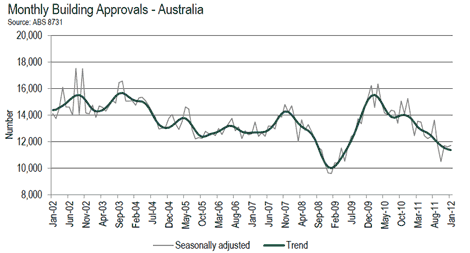Building approvals down in January, led by 25% fall in Victoria: HIA
Approvals for the construction of new homes in Victoria in January fell 25% year-on-year, according to new ABS figures.
On a seasonally adjusted basis there were just 2,348 approvals in Victoria in January 2012, compared with 3,138 in January 2011.
There were also small falls in private sector house approvals in New South Wales and WA.
Queensland was the strongest state for private sector house approvals, recording a 31% increase month-on-month.
Nationally, building approvals for both houses and units – a forward indicator of demand for new housing – continued to trend downward despite a big jump in NSW apartment approvals and a small improvement in January.
Click to enlargeIn the month of January 2012 total seasonally adjusted building approvals increased by 0.9% to 11,729, with approvals for new house construction remaining flat at 0.1% (7,508 houses) and approvals for units and other non-detached housing rising 1.5% (4,024 units).
Total seasonally adjusted building approvals increased by 7% in South Australia in January 2012, and in trend terms approvals rose by 2.6% in the Northern Territory.
In January this year total seasonally adjusted building approvals fell by 2.7% in Victoria, 22.1% in Queensland, 0.3% in Western Australia and 2.9% in Tasmania.
The trend number of building approvals fell by 13.9% in the Australian Capital Territory.
Despite the monthly improvement, overall approvals are down a cumulative 14.6% on figures a year ago with detached house approvals down 7.4% for the year and the more volatile apartments market down 23.3%.
The bright spot in the figures was NSW, with approvals rising 37.6% over the month led by a massive 90% jump in approvals in the more volatile apartments market.
Excluding NSW, HIA economist Harley Dale says approvals fell by nearly 9% in January.
“Housing has a large reach into the wider domestic economy in terms of both output and employment and urgent attention is required to turn the new residential building sector around,” he says.
“The profile for building approvals in late 2011/early 2012 continues to imply a level of housing starts comparable to the very weak levels endured around the GFC. It’s hard to call that a bright update for the domestic economy,” says Dale.
“Australia’s interest rate settings are too high and there needs to be immediate government focus on policy reform to boost flagging levels of new housing supply.”
CBA economist James McIntyre says the January building approval figures add to the “do-nothing” case for the RBA.
“It is too early to see the impacts from last year’s cuts. They are yet to filter through. At the same time, the data does not show any material weakening, which would be required to get the RBA to move off the sidelines,” he says.
“Our current expectation is that the RBA will cut rates once more in the second quarter of 2012.”
